Pennsylvania Hospital
Introduction
Text-to-speech Audio
Images
Pennsylvania Hospital, the Pine Building, dating to 1755 (image from Visit Philly)
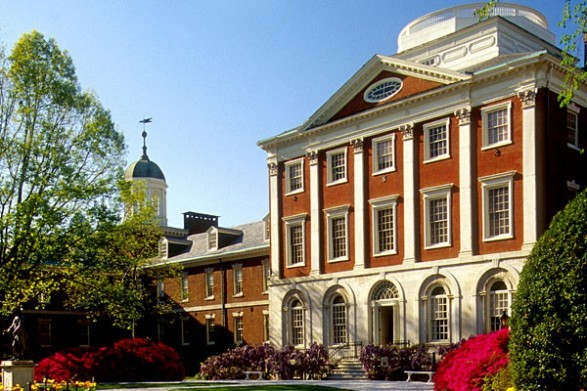
Interior of the Pine Building's central section, built 1804 (image from ocffreality.com)
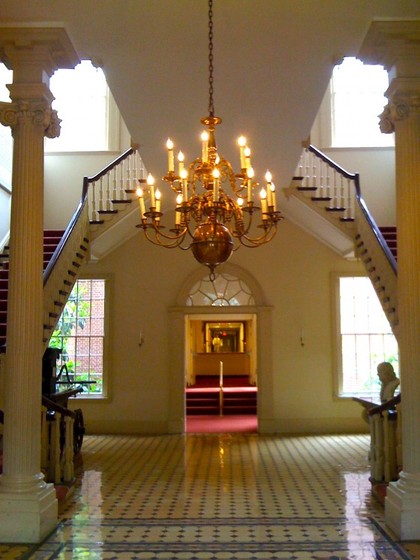
Historic library of Pennsylvania Hospital, dating to 1807 (image from Penn Medicine)
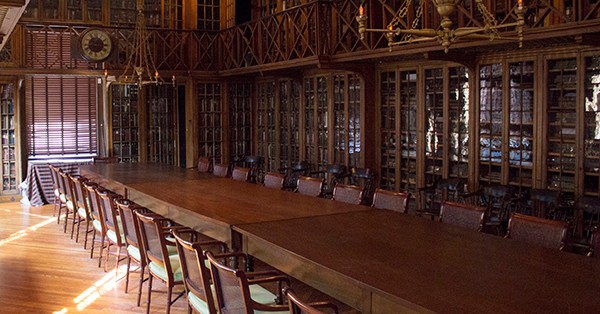
First surgical amphitheater in the U.S. at Pennsylvania Hospital, used 1804-1868 (image from University of Pennsylvania)
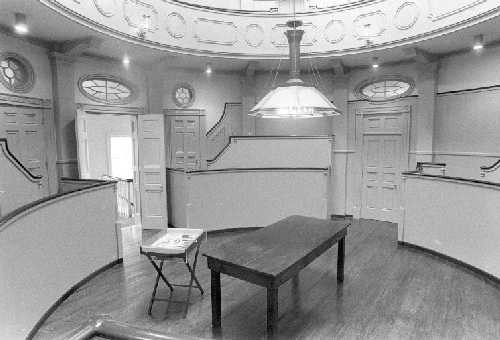
Elevation drawing of Pennsylvania Hospital by William Strickland, 1755 (image from Wikimedia Commons)
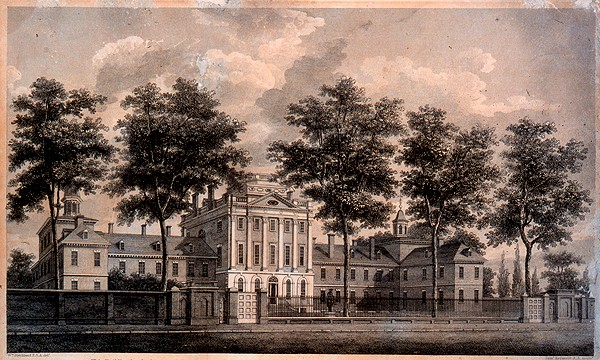
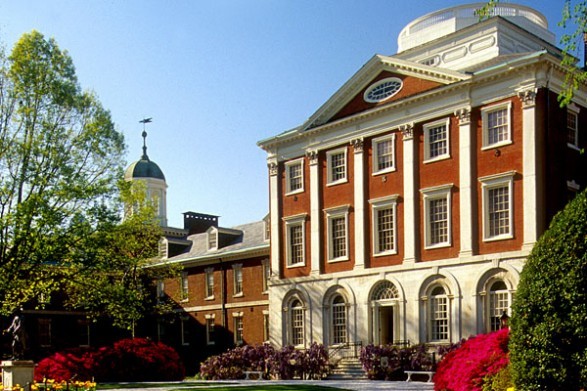
Backstory and Context
Text-to-speech Audio
Founded by Dr. Thomas Bond and Benjamin Franklin, the Pine Building of Pennsylvania Hospital, which opened in 1756, is the site of many American firsts. The hospital itself was the first in the nation, and within its walls are the first surgical amphitheatre, first hospital apothecary, and first medical library (all dating to 1804). It was the first American hospital to treat mental illness as a curable sickness and not possession. On its grounds are a Colonial garden and the Physic Garden, which is dedicated to 18th century medicinal plants and herbs. Its staff has included the father of clinical medicine (Dr. Thomas Bond), the father of American psychiatry (Dr. Benjamin Rush), and the father of American surgery (Dr. Philip Syng Physick) [2; 5].
History of Pennsylvania Hospital
Philadelphia, by the middle of the 18th century, was a busy port and the fastest-growing city in the American colonies. Though populated primarily by a solid middle class, the city took in thousands of immigrants between 1730 and 1750, many of whom were poor and mentally or physically ill upon arrival. Dr. Thomas Bond (1712-1784), a Quaker from Maryland who had studied in both London and Paris, was appointed Philadelphia's Port Inspector for Contagious Diseases in 1739. In 1750, Bond proposed the idea of a Philadelphia hospital, which would be the first such facility in America. City leaders responded by asking Bond what Benjamin Franklin's view on the matter was. Bond and Franklin were old friends, fellow members of Franklin's Library Company and co-establishers of the American Philosophical Society and the Academy of Philadelphia (later the University of Pennsylvania). Though Bond had assumed Franklin would be disinterested in the idea of a hospital, Franklin strongly supported the idea [2; 4]. Franklin brought a signed petition before the Pennsylvania Assembly on January 20, 1751, proposing a small hospital "to care for the sick poor of the Province and for the reception and care of lunaticks" [2]. When some of the Assembly balked at the bill for the proposed undertaking, Franklin offered to raise 2,000 pounds from private citizens if the Assembly would match the amount. When Franklin returned with more than 2,000 pounds, the Assembly signed the bill, which was signed into law by Governor James Hamilton on May 11, 1751 [2].
From 1752 until 1755, a temporary hospital was set up in the home of the late John Kinsey, Speaker of the Assembly prior to his death. A Quaker widow, Elizabeth Gardner, was appointed matron, and Dr. Bond volunteering his services as a doctor. The first patients (six of them psychiatric patients) were admitted on February 11, 1753. The Board of Managers refused admission to all incurable patients except "lunatics", patients suffering from small pox or other infectious diseases (until proper facilities were built), and women and children unless the children were cared for off-site. All admitted patients were required sponsorship by two tax-paying citizens who agreed to pay burial expenses or transportation to their homes upon recovery. In part, this was due to the Quaker value of work ethic, and Quaker sensibilities were also behind some of the hospital rules, including that patients were required to follow the orders of doctors and nurses and to help care for other patients if they were capable of doing so. Profane language, gambling, wearing street clothes in bed, and spitting on the floors were strictly prohibited [2; 4].
The first tract of land for the hospital was purchased from the Penn family in 1754, and the cornerstone for the East Wing was inscribed by Benjamin Franklin and laid the following year. The Colonial/Federal style Pine Building was designed by architect Samuel Rhoads, who would later join the hospital's Board of Managers. The East Wing was opened to patients in 1756. Psychiatric patients were held in cells on the ground floor (now considered the basement), a men's ward occupied the second floor, and the women's ward was on the third, with the top floor housing hospital employees and patients who required isolation. The hospital's official seal is an image of the Good Samaritan, its inscription, "Take care of him and I will repay thee" [2]. In 1762, Englishman Dr. John Fothergill, a friend of Benjamin Franklin's, donated the first book to Pennsylvania Hospital's medical library; five years later, Thomas and Richard Penn donated the remainder of the square at Spruce and Pine Streets and 8th and 9th Streets to the hospital. In 1766, Bond began a series of clinical lectures for students; he is considered the American father of clinical medicine for these lectures. Pennsylvania's first medical resident, Jacob Ehrenzeller, was appointed in 1773, and served until 1778. Pennsylvania Hospital cared for both Revolutionaries and British soldiers during the American Revolution. Four members of the Board of Managers were exiled, and the hospital's finances were impacted for years after the end of the war. In 1780, the hospital acquired its own fire engine, a hand-pumper built by Philadelphian Richard Mason, which is on display in the Great Court of the Pine Building today [2].
Dr. Benjamin Rush (1745-1813), now hailed as the father of American psychiatry, joined the Pennsylvania Hospital staff in 1783. Rush was a graduate of the University of Edinburgh, Scotland, and had studied in London and Paris for two years before returning to Philadelphia in 1769. He established his own medical practice, as well as taking on the roles of Resident Port-Physician, Fleet Surgeon of the Pennsylvania Navy, Physician General of the Military Hospital of the Middle Department of the American Army, President of the Philadelphia Medical Society, and Fellow of the College of Physicians. As if his medical obligations were not enough, Rush was also President of the American Society for the Abolition of Slavery. Like Franklin, had signed the Declaration of Independence in 1776. In the same year, Rush wrote a treatise on military medicine which was considered the definitive work on the subject until the American Civil War. He put a stop to the chaining and locking up of mentally ill patients in basement cells, as well as the treatment of the mentally ill as a form of entertainment by the townspeople. Rush was the first American physician to treat mental illness as a sickness rather than a spiritual affliction, believing that psychiatric problems were the result of an inflammation of the brain [2; 4]. In addition to recreational and occupational therapy, Rush also designed and utilized a "tranquilizing chair" which confined patients, under the theory that decreasing muscular action would slow the circulation of blood to the brain [4]. Some of the psychiatric patients to be treated at Pennsylvania Hospital during Rush's tenure included his own son, John Rush; Mary Girard, the wife of merchant and financier Stephen Girard; and the painter Raphaelle Peale, son of Charles Willson Peale.
For both mental and physical illnesses, Rush was a proponent of the "heroic" treatment of illness (blood-letting and purging) [2; 4]. During Philadelphia's 1793 Yellow Fever epidemic (see Lazaretto Quarantine Station), a fierce debate arose between physicians who treated the disease through "heroic" measures and those who believed (rightly) that such treatments taxed the patient's already weakened body [3; 4]. Particularly since Yellow Fever results in massive loss of fluids via bleeding, vomiting, and diarrhea, further inducement of the same symptoms by doctors, in fact, likely contributed to the death toll caused by the epidemic, which killed approximately one fifth of the city's population [3]. Nonetheless, Rush and his supporters (including Dr. Philip Syng Physick, who joined the Pennsylvania Hospital staff the following year) truly believed in their cure—so much so that when Rush and Physick contracted the fever themselves, Rush bled both himself and Physick. Both physicians recovered, though not because of the treatment [2; 4].
As the hospital's reputation for compassionate care of the mentally ill under Rush's watch increased, so too did the number of mentally ill patients, who outnumbered the physically ill of Pennsylvania Hospital by the turn of the century [2; 4]. Though construction had begun on the west wing and center section of the Pine Building in 1794, the Board of Managers struggled financially to pay for the necessary labor and materials, and the state government provided far less funding than was needed. Private philanthropists enabled the completion and extension of the west wing, which was designated for the care of the mentally ill, in 1796-97. The central section of the Pine Building, though not completed until 1804, was in use beginning in 1800. Designed as a buffer between the physically and mentally ill, the central section was built in the Federal style, slightly updated from Rhoads' original plan in order to save money. It housed a residential area for servants and staff, the nation's first apothecary, the nation's first medical reference library, the administrative center in the Great Court, and America's first surgical amphitheatre on the third floor. Another national first, Pennsylvania Hospital created its "lying-in" (maternity) department in 1803 [2].
It was in the Pennsylvania Hospital surgical amphitheatre that Dr. Physick earned his reputation as the father of American surgery, the first medical specialty of the nation. With seating for 180 and standing room for 300, surgeries were observed by both medical students and local citizens, who paid to watch operations, which were performed on sunny days between 11 am and 2 pm (for optimum light). Common surgical procedures included the removal of tumors, bladder stones, and cataracts; amputations; and repair of hernias and fractures [2].
In 1804, a statue of William Penn was donated to the hospital by his grandson, John Penn. It was placed in the hospital gardens, where it still remains today. The hospital gardens, which were used to exercise psychiatric patients, contain wisteria vines and azalea bushes estimated to be over 100 years old. The medical library was moved to its permanent home in 1807 (though it was temporarily used as the maternity ward from 1824-1835); this collection has grown to over 13,000 volumes of medical, scientific, botanical, and natural history books, as well as hospital archives, paintings, photographs, and memorabilia [2]. Several books date to the 15th century, before the printing press was invented, and the most complete collection in the United States of medical books published between 1750 and 1850, including Benjamin Rush's 1812 Observations and Inquiries upon the Diseases of the Mind [2; 4]. Artist Benjamin West donated his painting "Christ Healing the Sick in the Temple" to Pennsylvania Hospital in 1817. The hospital built a special area for it and charged admission to visitors to see it; 30,000 people came in the first year, raising $15,000 for the hospital [2].
In 1832, a resolution was passed to build a separate facility for proper care of the mentally ill, who outnumbered physically ill patients by two to one. The Pennsylvania Hospital for the Insane (later The Institute of Pennsylvania Hospital) was established at present-day 44th and Market Streets, on a large farm in 1841, and later included a separate ward for men at 49th and Market, built in 1859 (this campus remained in use until 1997, when the buildings were sold and the psychiatric treatment center returned to the Pennsylvania Hospital campus itself). Dr. Thomas Story Kirkbride, a Quaker, was named Superintendent in 1844, becoming one of the founding members of the organization which we now know as the American Psychiatric Association, as well as the still-operational Ivy League Private Psychiatric Hospital Group. Like his predecessor, Benjamin Rush, Kirkbride believed that mental illness could be cured. He practiced "moral treatment," including occupational therapy, recreational activities such as the on-site swimming pools, and educational opportunities including libraries for the patients. In addition, he believed in helping patients participate in "normal" social activities, including "magic lantern" shows, an early form of slide projection using candles for illumination. Guest speakers came to talk patients through the slides. Shows included themes of astronomy, history, religion, temperance, and travelogues [4].
Meanwhile, at the Pine Building, surgeons began to use anesthesia for female patients in 1846; male patients received the more traditional surgery preparations of physicians getting them drunk, giving them opium, or tapping them unconscious with a mallet. Not until the 1890s would sterilization be common practice in America, at Pennsylvania Hospital or elsewhere. Nonetheless, Pennsylvania Hospital's reputation for surgery drew in 124 Civil War casualties for special treatment. In 1898, approximately 300 wounded in the Spanish American War were brought to the hospital, and during World War I, Pennsylvania Hospital sent units to France at Base Unit No. 10, where 48,000 patients were treated. During World War II, the hospital's 52nd Evacuation Hospital served the Pacific Theater [2].
The hospital established its Women's Building (now called the Spruce Building) for obstetrics and gynecology in 1929 (moved to the Preston Building in 1961), and several specialized units in the 1950s and 1960s, including neurological intensive care, coronary, orthopedic, diabetes, oncology and urology, hospice, and outpatient mental health. To honor the hospital's 225th anniversary and the bicentennial of American Independence in 1976, the Pine Building underwent restoration, returning to traditional Colonial colors, refurbishing the William Penn statue and 150-year-old Portuguese tile in the Great Court (the first floor of the central section), and the creation of the Physic Garden, which had been planned and approved in 1774, but never realized. Originally designed by Martha Ludes Garra, the Physic Garden contains medicinal plants and herbs used in the 18th century, and was finally planted with the help of the Philadelphia Committee of the Garden Club of America [2].
In 1997, Pennsylvania Hospital and the health system of the University of Pennsylvania (also founded by Benjamin Franklin) merged. The hospital continues groundbreaking work, particularly in the fields of fertility and psychiatric treatment. The historic Pine Building is open to the public, and several online exhibits are available through the hospital's historic library. These include Anatomical Drawings, Flower to Pharmacy Exhibition, Natural History, Pennsylvania Hospital Serves in War, Psychiatry, Schools of Nursing at Pennsylvania Hospital (1914-1965), Surgical Amphitheatre, and Works that Altered the Course of Modern Medicine [2].
Historic Marker Inscription:
Pennsylvania Hospital
This is the first hospital in the U.S. Chartered by Colonial Assembly in 1751 for "relief of the sick poor." Benjamin Franklin and Dr. Thomas Bond were its chief founders. First building, erected in 1755, is still used [1].
East Wing Cornerstone Inscription:
IN THE YEAR OF CHRIST / MDCCLV / GEORGE THE SECOND HAPPILY REIGNING / (FOR HE SOUGHT THE HAPPINESS OF HIS PEOPLE) / PHILADELPHIA FLOURISHING / (FOR ITS INHABITANTS WERE PUBLICK SPIRITED) / THIS BUILDING / BY THE BOUNTY OF THE GOVERNMENT, / AND OF MANY PRIVATE PERSONS, / WAS PIOUSLY FOUNDED / FOR THE RELIEF OF THE SICK AND MISERABLE. / MAY THE GOD OF MERCIES / BLESS THIS UNDERTAKING. / LAID MAY 28, 1755 / as written by Benjamin Franklin [2].
Sources
1. Morfe, Don. "Pennsylvania Hospital Marker." Historic Marker Database. May 5, 2015. Accessed June 01, 2016. http://www.hmdb.org/marker.asp?marker=82984. 2. Penn Medicine. "History of Pennsylvania Hospital." Penn Medicine. Accessed June 01, 2016. http://www.uphs.upenn.edu/paharc/. 3. Powell, J. H. Bring Out Your Dead: The Great Plague of Yellow Fever in Philadelphia in 1793. Philadelphia: Univ. of Pennsylvania Press, 1949. 4. Sudak, Howard, M.D. "A Remarkable Legacy: Pennsylvania Hospital's Influence on the Field of Psychiatry." Penn Medicine. Accessed June 01, 2016. http://www.uphs.upenn.edu/paharc/features/psych.html. 5. Visit Philadelphia. "Pennsylvania Hospital." VisitPhilly.com. Accessed June 01, 2016. http://www.visitphilly.com/history/philadelphia/pennsylvania-hospital/#sm.0000edupgmvi8e6zsqy24tuzp7731.
